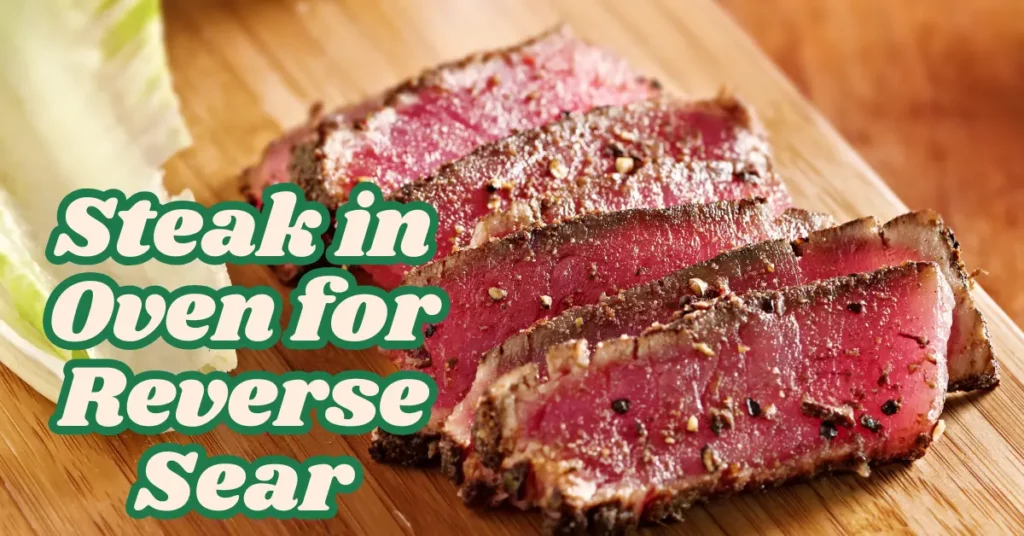This post may contain affiliate links. If you use these links to buy something we may earn a small commission. Thanks.
Reverse searing has quickly become a favorite cooking technique for steak lovers who crave a perfectly even cook with a restaurant-style crust. Unlike traditional methods that sear first and then finish cooking, reverse searing flips the script, and the result is nothing short of amazing. But one of the most common questions people have is: How long do you put steak in the oven for a reverse sear?
In this guide, we’ll break down the timing, technique, and tips so you can master the art of reverse searing like a pro.
What is Reverse Searing?
Reverse searing is a two-step process:
- Slow-cook the steak in a low-temperature oven until it’s just shy of your desired doneness.
- Quickly sear it in a screaming-hot pan to create that irresistible crust.
The beauty of reverse searing is how it delivers edge-to-edge doneness without overcooking the outer layers. This method prevents that gray band around the middle a common problem with traditional searing techniques. You get a tender, juicy inside and a deliciously crisp outer layer.
Why Reverse Sear Works So Well
- Better Temperature Control: Slow cooking allows you to gradually bring the internal temperature up, reducing the risk of overcooking.
- Superior Crust: A final high-heat sear creates a flavorful brown crust through the Maillard reaction.
- Juicier Results: The low-and-slow method locks in juices more effectively.

Best Cuts for Reverse Searing
While you can reverse sear almost any steak, it works particularly well with:
- Ribeye
- New York Strip
- Filet Mignon
- Porterhouse
- T-Bone
- Top Sirloin
Steaks that are at least 1 to 2 inches thick are ideal. Thinner cuts can overcook before the sear step.
Tools and Ingredients You’ll Need
To reverse sear properly, here’s what you need:
- Oven-safe meat thermometer or digital probe
- Cast iron skillet or stainless steel pan
- Wire rack + baking sheet
- High smoke-point oil (avocado, canola, grapeseed)
- Kosher salt and cracked black pepper
- Optional: Garlic cloves, rosemary, thyme, butter for basting
Step 1: Prepping the Steak
Bring to Room Temperature
Let your steak sit out for about 30–45 minutes before cooking. This ensures even cooking and better searing.
Pat Dry
Use paper towels to blot moisture from the steak. A dry surface ensures a crisp, golden-brown sear later.
Season Well
Generously season all sides with kosher salt and black pepper. You can also use garlic powder, onion powder, or a dry rub of your choice.
Step 2: Oven Cooking Temperature
The sweet spot for reverse sear is an oven temperature between 225°F and 275°F. Most people stick to 250°F it strikes the perfect balance between cooking time and moisture retention.
- Lower temp (225°F): Slower cook, more even doneness
- Higher temp (275°F): Faster cook, slightly more risk of overcooking the edges
Step 3: How Long to Cook Steak in the Oven
This depends heavily on the thickness of your steak and your desired doneness. Here’s a handy reference chart for oven time at 250°F:
| Steak Thickness | Doneness Level | Internal Temp Before Searing | Approx. Time in Oven |
|---|---|---|---|
| 1 inch | Medium-Rare | 120°F | 20–25 minutes |
| 1.5 inches | Medium-Rare | 120°F | 30–35 minutes |
| 2 inches | Medium-Rare | 120°F | 40–50 minutes |
Tip: Always rely on a meat thermometer rather than time alone. Every steak is different, and oven behavior can vary.
Target Internal Temperatures (Before Sear):
- Rare: 115°F
- Medium-Rare: 120°F–125°F
- Medium: 130°F
- Medium-Well: 135°F–140°F
Remember, the steak will gain another 5–10°F during the final sear.
Step 4: Time to Sear
Once your steak hits the target temperature in the oven, remove it and let it rest for 5–10 minutes while you preheat your skillet.
Preheat the Pan
Your skillet should be blazing hot — heat it for at least 5 minutes on high. This ensures a fast sear and maximum crust development.
Add Oil and Sear
- Add a bit of oil to the pan.
- Sear each side for 1–2 minutes, pressing gently for even contact.
- Don’t forget the edges — hold the steak with tongs and sear those too.
Optional Sear Enhancements:
- Toss in butter, garlic cloves, and herbs for a rich, aromatic finish.
- Baste the steak with melted butter while searing for extra flavor.
Step 5: Rest Again
After searing, transfer the steak to a cutting board and let it rest for another 5–10 minutes. This helps redistribute the juices evenly throughout the meat.
Don’t skip this step! Cutting too early can cause the juices to spill out, leaving your steak dry.
Pro Tips for Reverse Sear Perfection
- Use a wire rack on top of your baking sheet. It promotes airflow and helps cook the steak evenly on all sides.
- Dry brine overnight: Salt your steak and leave it uncovered in the fridge. It enhances flavor and improves the crust.
- Let steak cool briefly before searing: A short 5-minute cool-down before searing can help prevent overcooking during the final step.
- Avoid overcrowding the pan: Sear one steak at a time for best results.
Common Mistakes to Avoid
- Not using a thermometer: Guessing internal temp can lead to disappointment.
- Overcooking in the oven: Pull it a few degrees before your final doneness target.
- Skipping the rest period: This is essential to lock in moisture.
- Pan not hot enough: A cold pan leads to a weak crust and soggy exterior.
Frequently Asked Questions
Can I reverse sear in the oven only?
You can, but you’ll miss out on the signature crust. A stovetop sear or grill sear is crucial for texture and flavor.
Can I reverse sear a frozen steak?
Technically yes, but it’s not ideal. For best results, thaw your steak completely and let it come to room temperature before cooking.
Is reverse searing better than sous vide?
It depends on your preference. Both methods yield tender, perfectly cooked steaks, but reverse searing is easier and doesn’t require special equipment.
What’s the best cut for reverse sear?
Ribeye and New York Strip are favorites because they have a good balance of marbling and thickness.
Final Thoughts
Reverse searing is the ultimate method for steak lovers who want the best of both worlds — a juicy, evenly cooked interior and a crispy, flavorful crust. The key lies in low oven heat, accurate temperature monitoring, and a quick high-heat finish. Whether you’re cooking a casual weeknight dinner or impressing guests at a special occasion, reverse sear will never let you down.
So next time you’re craving steak, skip the guesswork and go for the reverse sear. You’ll be amazed at how a small shift in technique can elevate your cooking game to steakhouse level.
